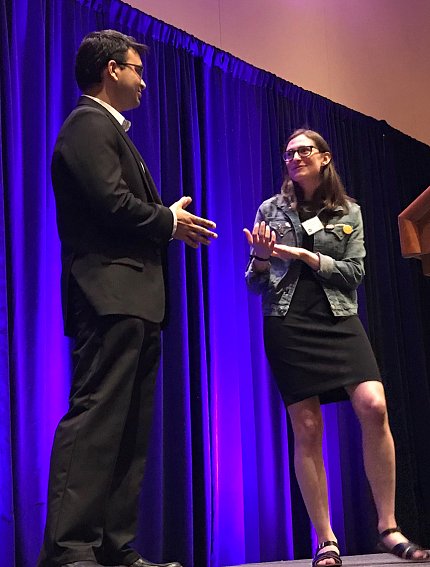Human Element Key
Results Alone Don’t Always Attract Science Press

Photo: Greg Lavine
When Washington Post reporter Sarah Kaplan evaluates a science pitch, she wants something more. She talked to attendees at an annual retreat for the NIAMS Intramural Research Program recently about how a human element can make a big difference.
Kaplan recalled her story about three curious graduate students working under cover of darkness on a secret project. The young scientists at the California Institute of Technology had a running debate over whether jellyfish sleep.
Taking matters into their own hands, they went to their laboratory after hours to gather data. The effort produced a science paper proving that jellyfish sleep.
“I might not have covered this story had it not been the story of the people involved with it,” Kaplan explained.
She offered tips on how to pitch stories to science reporters, including:
- Lose the jargon. When aiming a story for the public, avoid insider terms.
- Don’t oversimplify. Readers can digest complex ideas if they are explained using plain language.
- Make it visual. Graphics and photos help draw in readers.
- Put it in context. Explain how a finding fits into a field’s bigger picture.
- Tell the story behind the science. A human element behind a finding can connect readers to the science.
If a reporter is interested in a story, it is helpful for experts to know that not all science writers have a scientific background. Kaplan studied international affairs and came to science writing while working on the Post’s night shift. She discovered that many scientists stayed up late and were willing to talk.
The challenge can be getting scientists to speak plainly.
“My editor always tells me to pretend you’re talking to a really precocious 14-year-old,” Kaplan said. “A 14-year-old is smart and can pick up on ideas pretty fast, but also doesn’t necessarily have the vocabulary or background knowledge an adult who is a specialist might have.”
Dr. Sarthak Gupta, an NIAMS researcher, came on stage to test drive that advice with a practice interview. Gupta works on sex differences in autoimmune diseases such as lupus.
“Tell me about the most recent experiments you’ve worked on,” Kaplan asked.
“We wanted to assess whether there are actually any differences in gene expression profiles…” Gupta began.
Kaplan quickly interrupted with “…and gene expression is?”
After a few halting attempts at a definition, he laughed. Gupta shared how hard he found it to define something his colleagues take for granted.
Kaplan said she is energized talking to scientists, who are often excited to share their research.
“There’s a lot of commonality between scientists and journalists,” she said. “We’re [both] trying to get at the truth. We’re [both] trying to understand how the world works and why the world works the way it does.”
Sometimes the smallest question, like whether jellyfish sleep, can be just enough to bring journalists and scientists together.
